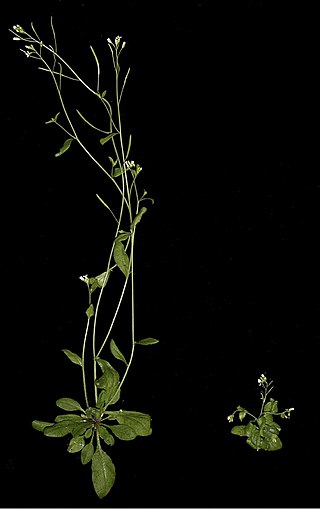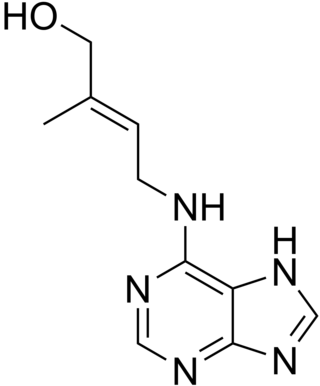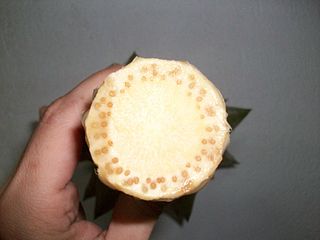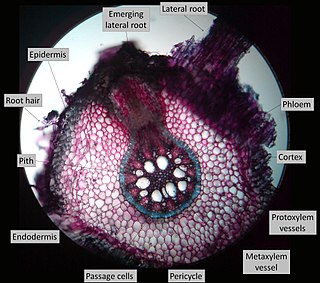Related Research Articles

Plant hormones are signal molecules, produced within plants, that occur in extremely low concentrations. Plant hormones control all aspects of plant growth and development, from embryogenesis, the regulation of organ size, pathogen defense, stress tolerance and through to reproductive development. Unlike in animals each plant cell is capable of producing hormones. Went and Thimann coined the term "phytohormone" and used it in the title of their 1937 book.

Auxins are a class of plant hormones with some morphogen-like characteristics. Auxins play a cardinal role in coordination of many growth and behavioral processes in plant life cycles and are essential for plant body development. The Dutch biologist Frits Warmolt Went first described auxins and their role in plant growth in the 1920s. Kenneth V. Thimann became the first to isolate one of these phytohormones and to determine its chemical structure as indole-3-acetic acid (IAA). Went and Thimann co-authored a book on plant hormones, Phytohormones, in 1937.

Cytokinins (CK) are a class of plant hormones that promote cell division, or cytokinesis, in plant roots and shoots. They are involved primarily in cell growth and differentiation, but also affect apical dominance, axillary bud growth, and leaf senescence.
Gibberellins (GAs) are plant hormones that regulate various developmental processes, including stem elongation, germination, dormancy, flowering, flower development, and leaf and fruit senescence. GAs are one of the longest-known classes of plant hormone. It is thought that the selective breeding of crop strains that were deficient in GA synthesis was one of the key drivers of the "green revolution" in the 1960s, a revolution that is credited to have saved over a billion lives worldwide.

Coleoptile is the pointed protective sheath covering the emerging shoot in monocotyledons such as grasses in which few leaf primordia and shoot apex of monocot embryo remain enclosed. The coleoptile protects the first leaf as well as the growing stem in seedlings and eventually, allows the first leaf to emerge. Coleoptiles have two vascular bundles, one on either side. Unlike the flag leaves rolled up within, the pre-emergent coleoptile does not accumulate significant protochlorophyll or carotenoids, and so it is generally very pale. Some preemergent coleoptiles do, however, accumulate purple anthocyanin pigments.

An appressorium is a specialized cell typical of many fungal plant pathogens that is used to infect host plants. It is a flattened, hyphal "pressing" organ, from which a minute infection peg grows and enters the host, using turgor pressure capable of punching through even Mylar.
Moisture stress is a form of abiotic stress that occurs when the moisture of plant tissues is reduced to suboptimal levels. Water stress occurs in response to atmospheric and soil water availability when the transpiration rate exceeds the rate of water uptake by the roots and cells lose turgor pressure. Moisture stress is described by two main metrics, water potential and water content.

A primordium in embryology, is an organ or tissue in its earliest recognizable stage of development. Cells of the primordium are called primordial cells. A primordium is the simplest set of cells capable of triggering growth of the would-be organ and the initial foundation from which an organ is able to grow. In flowering plants, a floral primordium gives rise to a flower.
Turgor pressure is the force within the cell that pushes the plasma membrane against the cell wall.

Lateral roots, emerging from the pericycle, extend horizontally from the primary root (radicle) and over time makeup the iconic branching pattern of root systems. They contribute to anchoring the plant securely into the soil, increasing water uptake, and facilitate the extraction of nutrients required for the growth and development of the plant. Lateral roots increase the surface area of a plant's root system and can be found in great abundance in several plant species. In some cases, lateral roots have been found to form symbiotic relationships with rhizobia (bacteria) and mycorrhizae (fungi) found in the soil, to further increase surface area and increase nutrient uptake.

Etiolation is a process in flowering plants grown in partial or complete absence of light. It is characterized by long, weak stems; smaller leaves due to longer internodes; and a pale yellow color (chlorosis). The development of seedlings in the dark is known as "skotomorphogenesis" and leads to etiolated seedlings.
Polar auxin transport is the regulated transport of the plant hormone auxin in plants. It is an active process, the hormone is transported in cell-to-cell manner and one of the main features of the transport is its asymmetry and directionality (polarity). The polar auxin transport functions to coordinate plant development; the following spatial auxin distribution underpins most of plant growth responses to its environment and plant growth and developmental changes in general. In other words, the flow and relative concentrations of auxin informs each plant cell where it is located and therefore what it should do or become.
Expansins are a family of closely related nonenzymatic proteins found in the plant cell wall, with important roles in plant cell growth, fruit softening, abscission, emergence of root hairs, pollen tube invasion of the stigma and style, meristem function, and other developmental processes where cell wall loosening occurs. Expansins were originally discovered as mediators of acid growth, which refers to the widespread characteristic of growing plant cell walls to expand faster at low (acidic) pH than at neutral pH. Expansins are thus linked to auxin action. They are also linked to cell enlargement and cell wall changes induced by other plant hormones such as gibberellin, cytokinin, ethylene and brassinosteroids.
The plant cell wall is made up of hydrated polymetric material, allowing it to have viscoelastic properties. The primary cell wall of a plant consists of cellulose fibers, hemicellulose, and xyloglucans. This load bearing network is also surrounded by pectins and glycoproteins.

In biology, phototropism is the growth of an organism in response to a light stimulus. Phototropism is most often observed in plants, but can also occur in other organisms such as fungi. The cells on the plant that are farthest from the light contain a hormone called auxin that reacts when phototropism occurs. This causes the plant to have elongated cells on the furthest side from the light. Phototropism is one of the many plant tropisms, or movements, which respond to external stimuli. Growth towards a light source is called positive phototropism, while growth away from light is called negative phototropism. Negative phototropism is not to be confused with skototropism, which is defined as the growth towards darkness, whereas negative phototropism can refer to either the growth away from a light source or towards the darkness. Most plant shoots exhibit positive phototropism, and rearrange their chloroplasts in the leaves to maximize photosynthetic energy and promote growth. Some vine shoot tips exhibit negative phototropism, which allows them to grow towards dark, solid objects and climb them. The combination of phototropism and gravitropism allow plants to grow in the correct direction.

In botany, the Cholodny–Went model, proposed in 1927, is an early model describing tropism in emerging shoots of monocotyledons, including the tendencies for the shoot to grow towards the light (phototropism) and the roots to grow downward (gravitropism). In both cases the directional growth is considered to be due to asymmetrical distribution of auxin, a plant growth hormone. Although the model has been criticized and continues to be refined, it has largely stood the test of time.
Leaf expansion is a process by which plants make efficient use of the space around them by causing their leaves to enlarge, or wither. This process enables a plant to maximize its own biomass, whether it be due to increased surface area; which enables more sunlight to be absorbed by chloroplasts, driving the rate of photosynthesis upward, or it enables more stomata to be created on the leaf surface, allowing the plant to increase its carbon dioxide intake.
The P-type plasma membrane H+
-ATPase is found in plants and fungi. For the gastric H+
/K+
ATPase, see Hydrogen potassium ATPase.
The acid-growth hypothesis is a theory that explains the expansion dynamics of cells and organs in plants. It was originally proposed by Achim Hager and Robert Cleland in 1971. They hypothesized that the naturally occurring plant hormone, auxin (indole-3-acetic acid, IAA), induces H+ proton extrusion into the apoplast. Such derived apoplastic acidification then activates a range of enzymatic reactions which modifies the extensibility of plant cell walls. Since its formulation in 1971, the hypothesis has stimulated much research and debate. Most debates have concerned the signalling role of auxin and the molecular nature of cell wall modification. The current version holds that auxin activates small auxin-up RNA (SAUR) proteins, which in turn regulate protein phosphatases that modulate proton-pump activity. Acid growth is responsible for short-term (seconds to minutes) variation in growth rate, but many other mechanisms influence longer-term growth.

Ethylene (CH
2=CH
2) is an unsaturated hydrocarbon gas (alkene) acting as a naturally occurring plant hormone. It is the simplest alkene gas and is the first gas known to act as hormone. It acts at trace levels throughout the life of the plant by stimulating or regulating the ripening of fruit, the opening of flowers, the abscission (or shedding) of leaves and, in aquatic and semi-aquatic species, promoting the 'escape' from submergence by means of rapid elongation of stems or leaves. This escape response is particularly important in rice farming. Commercial fruit-ripening rooms use "catalytic generators" to make ethylene gas from a liquid supply of ethanol. Typically, a gassing level of 500 to 2,000 ppm is used, for 24 to 48 hours. Care must be taken to control carbon dioxide levels in ripening rooms when gassing, as high temperature ripening (20 °C; 68 °F) has been seen to produce CO2 levels of 10% in 24 hours.
References
- ↑ Majda and Robert, Mateusz and Stepahnie (March 22, 2018). "The Role of Auxin in Cell Wall Expansion". International Journal of Molecular Sciences. 19 (4): 4. doi: 10.3390/ijms19040951 . PMC 5979272 . PMID 29565829.
- ↑ Rayle, D. L.; Cleland, R. E. (1992). "The Acid Growth Theory of auxin-induced cell elongation is alive and well". Plant Physiology. 99 (4): 1271–1274. doi:10.1104/pp.99.4.1271. PMC 1080619 . PMID 11537886.